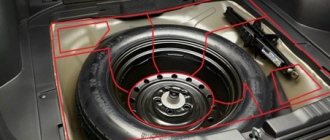09:47 Andrey Ku Home page » Affiliate news
Relatively recently, the current legislation has undergone changes that affect the introduction of penalties for tires installed on a vehicle that do not correspond to the season.
This innovation led to the problem of how to store tires without rims. And not even half of all motorists have knowledge on this issue. For this reason, it is worth paying special attention to all the nuances, because rubber needs special care. Especially one that hasn't been used for six months.
Naturally, you don’t have to stress and buy new tires every season. However, no more than 10% of road users can use this approach to the problem. Firstly, it is very expensive. And secondly, where to store used tires? And even more so, in what position should they be stored?
Basic storage rules
First of all, the motorist must prepare a place to store tires, as well as ensure the correct conditions. When choosing a room, it is worth considering that the following factors have a negative impact on tires:
- Dampness;
- Presence of dirt;
- Exposure to ultraviolet radiation;
- Exposure to high temperature.
Accordingly, the ideal place would be a dark and dry room, the temperature in which does not exceed +25 degrees.
It is important to remember that tires are sent for seasonal storage only in clean form.
It is convenient to store clean tires in special bags
For this reason, the rubber must be thoroughly washed and dried. In addition, it is worth cleaning large stones and other foreign objects from the tread. If, during inspection of the tire, a self-tapping screw or nail is found in it, they must be removed. And it’s better to do this at a tire shop and then repair the damage site. There you can also check the tires for the presence of hernias or deep cracks, which after storage will become an unpleasant occurrence for the motorist.
When the tires are completely cleaned and prepared, each tire can be treated with a special preservative, for example, silicone grease. This product is absorbed into micropores and prevents the absorption of moisture by rubber. When choosing a product, you should pay attention to the composition and active ingredients. The drug must be without solvent.
Temperature
Rubber used on cars in the summer cannot be stored at low temperatures. If summer tires are allowed to freeze, the fiber structure will be damaged. This will lead to cracking and unsuitability of rubber for use.
Storing winter tires is easier because such wheels have a softer structure. But high temperatures during storage can affect the performance of such tires. In this case, the tires must be placed in any position other than vertical.
Air humidity
If the air humidity in the room exceeds 85%, then it is better to abandon such a storage location. Even using an electric heater that dries out the air will not help solve the problem. By the way, the air in the room where the heater is operating has a negative effect on tires. Ideal air humidity conditions for storing wheels are considered to be between 50 and 80%. You can heat the room with standard radiators. However, wheels must be stored at least one meter away from the heating system.
The lack of ventilation in the room can create additional difficulties for a motorist in finding an ideal place for seasonal storage of tires.
Wheel locations
Many car enthusiasts rack their brains over which side they should put their wheels on after storage. To save yourself from this problem, each tire can be marked. When the tread pattern is directional and the wheels have been stored without removing them from the rims, you just need to put the appropriate marks on each axle. You can use multi-colored caps on the nipple (for example, the front tires will receive black caps, and the rear wheels will have gold caps).
Washing and processing
It has already been noted that tires must be sent for storage in their pure form. It is worth removing not only dirt, sand and stones from the tread from the surface of the rubber, but also oil stains. Next, it is recommended to apply a special agent with preservative properties to the rubber. You can find such a sprayer on the shelves of any specialized auto store. By the way, if a motorist cannot make a decision on choosing a product on his own, only store consultants will help him in this matter.
It is worth remembering that rubber dye cannot be used to treat tires. In such products, the active component is a solvent, which, with prolonged exposure to rubber, negatively affects it. Before processing, you should carefully study the manufacturer’s instructions for the product and strictly follow them during the application process. Any deviation from the list of actions on the packaging may lead to damage to the tires.
The last step before sending the tires for seasonal storage is packaging the wheels in plastic bags. It is better to use dark-colored bags that will prevent exposure to ultraviolet radiation.
It is important to remember that hermetic closure is not permitted. In the bag where the tires are placed on the rims, condensation will accumulate, which will have a detrimental effect on the metal. In bags where tires are simply stored, it is necessary to ensure good air circulation.
Do-it-yourself wheel storage in the garage
As mentioned earlier in the article, shelves and racks are great for properly storing tires. You can easily buy such designs. But if finances do not allow, then it is possible to build it yourself. You only need to purchase materials and components. All the necessary tools are likely to be found in every garage.
On a note!
If there is very little space in the garage, then a hanging shelf for wheels will be an excellent solution. It can be made of wood or metal. The main thing in this matter is to securely attach the mounts to the wall. This will determine whether the tires will fall off.
Before building the shelf, you need to measure the tires and draw a rough diagram. And then use it to fasten all the parts together. For the metal version, welding will be required. If it is not there, then you can make it wooden, but just be sure to paint and varnish at the end. Otherwise, the timber will not last long and the shelf will rot.
You might be interested in this About all-terrain tires
The rack is made based on preliminary measurements. Approximate diagrams can be found on the Internet or you can come up with an individual version. The wheels that will be placed on the shelf should not come into contact with the wall. The distance should be at least one centimeter. Winter tires should be stored in a dry, ventilated garage at a temperature not exceeding 25 °C. Incorrect humidity and temperature standards will lead to its deterioration.
Storage in the pantry
A pantry or dark room in an apartment is considered to be a place for storing rubber with ideal conditions. There is never a sharp temperature change in this room, it is well ventilated, and the path of sunlight into the room is completely limited. In addition, it is extremely rare for apartment owners to store aggressive chemicals in a dark room that can ruin car tires.
But the pantry also has disadvantages, which are as follows:
- Not every apartment in an apartment building is designed by the architect to have a dark room.
- Often this room is made of a small area, and it is extremely difficult to place a set of tires there at once.
But if there is a dark room in the apartment and its area allows you to store four car wheels at the same time, then you cannot find a better place.
How to store in a garage
It is worth sending wheels for seasonal storage in the garage only if the room is built of brick and has a good heating system. In any other case, there will be an increased level of humidity in the garage, which can lead to damage to the wheels during long-term storage and the danger of using such tires on a car.
One of the options for properly storing tires on rims in the garage
Other disadvantages of garage storage include:
- Lack of ability to constantly heat the room. The most suitable temperature for unused rubber is considered to be in the range from 10 to 25 degrees. As soon as the thermometer shows less, the structure of the tires will change and not at all for the better.
- Storage of auto chemicals in garages, the vapors of which have a negative effect on rubber. And this is not even to mention the accidental spillage of gasoline or oil into the bags with wheels.
Storage on the balcony
Car owners often store tires on the balcony. If it is glazed, then there is a certain microclimate inside. This circumstance makes it possible to prevent sudden temperature changes and high humidity. But even a glass frame cannot save rubber from the negative effects of sunlight. Therefore, the motorist must independently take care of protecting the tires and pack them in dark plastic bags.
Tires can be stored hanging on the balcony, but only together with rims
Storing wheels on an open balcony becomes almost impossible. This is due to the fact that even packed tires will get rainwater and dirt from the street along with dust. And it is impossible to regulate the temperature by opening or closing the windows on such a balcony.
It is important to remember that at temperatures below +10, the wheels should be immediately removed to a warm room. Therefore, storing wheels on the balcony during the winter season is not recommended.
The controversial issue of polyethylene
This item is for those who do not know how to store tires without rims on the balcony. Some people strongly recommend wrapping tires in dark bags, others insist on the dangers of polyethylene. Actually the answer is simple. It is not so much the cellophane itself that is harmful, but the condensation that forms on its inner surface. To avoid moisture in the bag, close it loosely to allow air to circulate.
Dark polyethylene can be a good help when storing rubber on the balcony: it will protect tires from exposure to ultraviolet radiation. If the tires are kept in a dark and dry room, then bags are not needed.
Currently, special covers are sold that can be used instead of polyethylene. It will be a little more expensive, but this “wrapper” is more durable, and the storage conditions will be met. The covers are made of dense dark materials that do not allow sunlight to pass through, but are at the same time breathable. In this case, condensation will not appear.
What is a tire hotel
Relatively recently, specialized tire centers have introduced a service for accepting wheels from citizens for seasonal storage. For the safety of tires for seven months you will have to pay from 1700 to 3500. The cost of the service depends on the diameter of the tires. If a motorist brings a 13-inch set of tires, then the price tag is calculated based on the minimum threshold. Accordingly, the maximum fee will be charged for tires from 22 inches.
This is what tire storage looks like in a tire hotel
In most cases, company managers are loyal to what a person brings for storage: only a set of tires, or wheels and rims. Payment is taken from the client for the place where tires are stored. However, there are also situations where tire hotels will require an additional sum of money to prepare the wheels for seasonal storage. Usually the price tag for such a service does not exceed 500 rubles.
The advantages of tire hotels include the fact that re-shoes and special services for the vehicle will cost less for the client who left the tires for storage.
The job of tire hotels is not to sweep away dust from tires every day, but to save customers from finding a place to store tires for the season. The service in question is especially popular among citizens who are in no hurry to clean a place on the balcony (if there is one), sort things out in a closet, or build a garage specifically to accommodate wheels. It’s easier for such people to pay for storage and come pick up their tires with the onset of the new season.
Average prices for tire storage
If it is not possible to create the necessary conditions for optimal preservation of car tires, you can use the special services provided by car services. Each car service sets its own price. Below is a table with the average price range for these services.
| Storage period | R13-R16 (passenger cars) | R17-R21 (passenger cars) | R15-R21 (jeep) |
| Winter period | 900-1100 rubles | 1100-1300 rubles | 1100-1300 rubles |
| Summer period | 1100-1300 rubles | 1400-1600 rubles | 1400-1600 rubles |
What are the dangers of improper storage?
If the conditions for storing rubber are not observed, the car owner may encounter the fact that the wheels will become unsuitable for use.
It is important to understand that exposure to the main enemy of rubber - ultraviolet radiation, along with exposure to humid air, causes tires to dry out.
Due to the change in structure, the beads and side walls of the tires become deformed. In addition, increased humidity causes tires to lose their former elasticity. Without this, the wheels will wear out quickly. As noted, the ideal air humidity value for seasonal tire storage is in the range from 55 to 80%. This parameter can be achieved by ventilating the room. Naturally, if it does not have ventilation systems that allow the car owner not to open the windows every day.
How to store tires on rims
The basic rule for storing a set of tires on rims is to strictly prohibit placing tires in a vertical position.
The dead weight of the tire and wheel is about 15 kilograms. Accordingly, under such weight, deformation of the sidewalls and cord will occur within a few months. It will be impossible to notice changes without measuring devices. But they definitely will. And such deformations will become a nuisance for the driving characteristics of the car, and will also affect the service life of the tires.
Options for proper storage of tires on rims
If it is not possible to place the tires in another way, experts advise turning the wheels 90 degrees every two weeks.
When preserving the entire vehicle for the cold season, it is recommended to roll the vehicle once every two weeks. This is done for the same reason given above.
You can store the assembled rubber set in a suspended state. In such a situation, the load will be evenly distributed on the disk and the tires themselves will not be subject to deformation.
When storing wheels on top of each other, it is important to remember the following recommendations:
- Before packing into bags, slightly reduce the tire pressure (it is best to leave it at 1.5 atmospheres).
- Rotate your tires monthly because the load on the bottom tires will be greater than on the top tires.
Garage: tires - storage standards
By adhering to storage rules , the wheels will last much longer . The benefit is obvious. The rules are not complicated; any car owner can follow them.
- Temperature - temperature can vary from -30 °C to +35 °C. The range is quite wide. If rubber was stored in a garage for a long time at a low temperature, then allow it to “warm up” before use (installation on a car). It is necessary for the air temperature to become positive. Please note that wheels should be stored at a distance of 1 meter or more from heating (radiators, etc.).
- Racks - ideally, tires should be stored in the garage on special racks or on a flat floor. The rack for tires in the garage should be level, without protruding corners. Long exposure to a sharp edge has a negative impact on the wheels. Standard tires up to 205 millimeters can be stacked on top of each other. The maximum height of such a stack is 2 meters. Larger tires (215mm or larger) should be stored vertically in rows.
- Sunlight/UV – Sunlight significantly weakens the strength of wheels and creates many microcracks. Visually, cracks are very difficult to notice. But the strength of the wheel still drops sharply. Other sources of UV radiation have similar effects, so you should not place tire storage racks near them in your garage.
Educational video about storing tires in the garage:
Tires should be rotated at least once every three months . This changes the contact surface, the wheels/tires are not subject to constant load. GOST allows storing tires outdoors for no more than one month .
In addition, they must be protected from sunlight, humidity, dust and dirt . This type of protection is easiest to provide if your garage tire storage racks have a cover or thick material. Please note that before installing the wheels on the car, you should thoroughly clean them and wipe them from dirt.
The room that serves as a warehouse must be insulated from the penetration of gases and vapors (for example, ozone). Often the source of gases can be equipment. Other harmful substances - gasoline , oil , solvent . Do not allow chemicals to come into direct contact with the tire surface. In addition, copper and corrosive metals also negatively affect the condition of tires.
There are practically no differences in storage rules for tires and wheel assemblies . But assembled wheels are less susceptible to moisture and dirt. They are provided with additional protection. There is also another advantage - there is no need to re-align the wheels with the onset of the new season.
How to properly store wheels in a metal garage? From the above recommendations it follows that it is theoretically possible . But special attention should be paid to temperature conditions and humidity levels .
If the garage is not heated and the temperature in your area drops below -30 ° C, then there is a risk of damage . The situation is similar with humidity . Dirt floors and poor ventilation create high humidity, which harms your tires. In other words, you should always check the standards.
Look at the recommendations in the photo on how to store tires on rims in the garage :
Storing summer tires without rims
Among car enthusiasts who are not privy to all the intricacies and nuances of seasonal wheel storage, there is an opinion that the same conditions can be used for both summer tires and winter tires. And such an opinion can confidently be called erroneous. The fact is that these types of tires differ in design. The structure of winter tires is softer, which makes these wheels great for use in cold weather. But as the temperature rises, the properties of the tires disappear. For summer tires the situation is exactly the opposite.
It turns out that the conditions in the room where the wheels are stored cannot be the same. Even though some requirements will be identical.
An important condition for storing summer tires without rims in winter is to maintain a room temperature of at least +10 degrees.
It is recommended to store tires without rims in a vertical position
In addition, you should avoid direct sunlight on the rubber. To ensure safety, it is worth packing tires in dark plastic bags. As a last resort, you can use regular garbage bags. Plastic packaging for wheels will protect them both from external natural factors and from accidental spills of auto chemicals if the tires are stored in a garage.
Preparing tires for storage
The main task before storing is to remove dirt from the tires. You can clean the wheels yourself or at a car wash. Pebbles stuck in the tread must be removed and the tires dried.
Treating tires with a preservative compound will help protect them from external negative influences. For example, silicone lubricant reliably impregnates tires and protects them from aging.
Each wheel should be marked with a symbol according to the fact of use in the current period: left front, right rear, etc. Such tips will help you timely change the location of the tire when fixing it next season. Following a simple rule promotes uniform wear of the rubber and, accordingly, increases the service life of the tire.
Features of storing summer tires
Compared to winter tires, summer tires are noticeably more capricious. Summer tires are designed for use in the warm season, and therefore require a dark and dry storage place with a temperature above 0°C. Prolonged frosts will make tires hard and brittle, and cracks may appear. Sustained exposure to low temperatures leads to rubber tanning. Subsequently, the adhesion properties of the wheels and the road surface will be impaired, and the behavior of the car will become unpredictable.
Features of storing winter tires
Winter tires do not like summer heat. High temperatures may damage the cord structure. It should be noted that the deep tread pattern requires careful cleaning to remove clogging, dust and dirt that affect the storage process.
Studded and non-studded winter tires should be kept in a dark, cool room. Therefore, you should avoid metal boxes and garages, which become particularly hot in the sun, or choose the most shaded and ventilated parts of the room for storing wheels in the garage.
Storing tires on rims
Tires on spare rims, according to experts, are least susceptible to deformation during storage. Additional convenience in quick seasonal wheel replacement.
There are three main ways to place tires on rims:
- In a stack. The load will be on the wheels, not the tires. The wheels must have special covers. If you don’t have them, you can make storage bags from durable plastic bags with your own hands. You cannot close such covers to avoid condensation and then rust on the discs.
- Hanging. Each disc is carefully secured to the middle with a rope and hung on the wall.
- On shelves. A rack for wheels in the garage is considered the optimal storage place. Hanging shelves attached to the ceiling with your own hands will significantly save space in the garage and ensure the integrity of the wheels.
It is important not to line up tires with rims. Heavy rims will put pressure on the tires from below. This will inevitably lead to tire deformation.
It is recommended to leave the tire pressure approximately 0.5 atmospheres lower than the standard for vehicle operation.
Storing tires without rims
The rules for storing tires without rims are different, since the rubber is more susceptible to deformation. The owner saves on spare wheels and must take into account the nuances of storing tires so that they are usable after a season.
You cannot stack tires in a box horizontally on top of each other. This is a serious mistake that leads to damage to even very high-quality rubber from improperly distributed pressure. The lower tire will be especially affected. It will not be possible to put it on the disk and put it into working condition.
According to the rules, tires without rims are stored in a vertical position. It is necessary to periodically rotate the tires to redistribute the load and ensure the safety of the rubber.
Horizontal placement is permissible in storing each tire on a separate shelf of the rack. It's not difficult to make it yourself.
It is not recommended to hang tires without rims on ropes. But if the space does not allow you to place the tires otherwise, then you need to at least thicken the rod or rope by wrapping soft material so that a mark does not form under the weight of the rubber. Hanging on metal hooks by the seat edge leads to deformation.
Motorists decide how to store tires based on financial capabilities, experience, and expert recommendations. The practice of storing tires in a garage is the best option for those who approach this task wisely.
”
Similar homemade products
Homemade garage compressor from an old refrigerator
DIY carport: made from four metal poles
Insulating the engine compartment of a car: do it yourself
Homemade garage: electric point
Setting up a garage: making an inspection hole
Manual homemade car wash for 500 rubles
Features of storing winter tires
Winter wheels feature soft tires without discs. For this reason, such wheels should be sent for storage together with the rims.
In addition, there are three more important nuances that affect the safety of winter tires:
- When stacking tires on top of each other, it is worth reducing the pressure setting in them so that the wheels do not become inflated (recommended level is 1.5 atmospheres).
- Take special care to clean the tread of stones and other objects (this part of the tire in winter wheels is much higher than in summer ones).
- Avoid exposure to direct sunlight and high temperatures.











